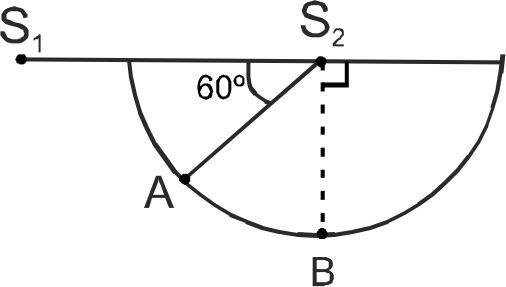S1 and S2 are two sources of sound emitting sine waves. The two sources are in phase. The sound emitted by the two sources interfers at point F. The waves of wavelength :

1m will result in constructive interference
23m will result in constructive interference
2m will result in destructive interference
4m will result in destructive interference
The correct Answer is:A, B, D
Step by step video, text & image solution for S_(1) and S_(2) are two sources of sound emitting sine waves. The two sources are in phase. The sound emitted by the two sources interfers at point F. The waves of wavelength : by Physics experts to help you in doubts & scoring excellent marks in Class 11 exams.
Updated on:21/07/2023Topper's Solved these Questions
- SOUND WAVESBook:RESONANCEChapter:SOUND WAVESExercise:Exercise- 2 PART - IV
Explore 8 Videos
- SOUND WAVESBook:RESONANCEChapter:SOUND WAVESExercise:Exercise- 3 PART - I
Explore 47 Videos
- SOUND WAVESBook:RESONANCEChapter:SOUND WAVESExercise:Exercise- 2 PART - II
Explore 20 Videos
- SIMPLE HARMONIC MOTIONBook:RESONANCEChapter:SIMPLE HARMONIC MOTIONExercise:Exercise
Explore 28 Videos
- STRING WAVESBook:RESONANCEChapter:STRING WAVESExercise:Exercise
Explore 32 Videos
Similar Questions
What is the luminous flux of a source emitting radio waves ?
View SolutionTwo source of sound, S1 and S2, emitting waves of equal wavelength 2cm, are placed with a separation of 3cm between them. A detector can be moved on a line parallel to S1S2 and at a distance 24cm from it. Initially, the detecor is equidistant from the two sources. Assuming that the waves emitted by the sources are in phase, find the minimum distance through which the detector should be shifted to detect a minimum of sound.
View Solution
Knowledge Check
Two sources of sound are in resonance when
Athey look likeBthey are situated at a particular distance from each otherCthey produce the sound of same frequencyDthey are excited by the same excittng deviceTwo radio frequency sources S1 and S2, separated by distance 2.5 m emitting in phase waves of wavelength 1m. A detector moves in a large circular path around the two sources in a plane containing them. The number of maxima that will be detected by it over the complete circular path. are
 A16B12C10D8
A16B12C10D8Figure shows two line sources of sound, S1andS2 separated by a distance 4 m.The two sources are in same phase at all times.The source emit same power and their lengths are also same.A detector moves along a circle with center at S2 and radius 3m. The wavelength of the sound is 1m.When it is at A the intensity of sound due to source S2 only is I0.

The intensity o sound of B due to S1andS2 is :A7025I0BI0[85+2√35]C8I05DI0[85+2√925]
S1,S2 are two choerent sources of sound located along x-axis separated by 4γ where γ is wavelength of sond emitted by them. Number of maximum located on the elliptical boundary around it will be :-

View SolutionFigure shows two line sources of sound, S1andS2 separated by a distance 4 m.The two sources are in same phase at all times.The source emit same power and their lengths are also same.A detector moves along a circle with center at S2 and radius 3m. The wavelength of the sound is 1m.When it is at A the intensity of sound due to source S2 only is I0.

The intensity of sound at A due to S1 only is :
View SolutionFigure shows two line sources of sound, S1andS2 separated by a distance 4 m.The two sources are in same phase at all times.The source emit same power and their lengths are also same.A detector moves along a circle with center at S2 and radius 3m. The wavelength of the sound is 1m.When it is at A the intensity of sound due to source S2 only is I0.

The intensity of sound at B due to S1 only is :
View SolutionAn isotropic point source of sound waves is emitting sound waves of power 314W in spherical wave fronts, If the sound source is located at the point (1, 2, 3), the intensity at point [4, 6,(3+5√3)], if all co-ordinates are measured in meters is :-
View SolutionS1 and S2 are two coherent sources of sound having no intial phase difference. The velocity of sound is 330m/s. No maximum will be formed on the line passing through S2 and prependicular to the line joining S1 and S2. If the frequency of both the sources is

View Solution

